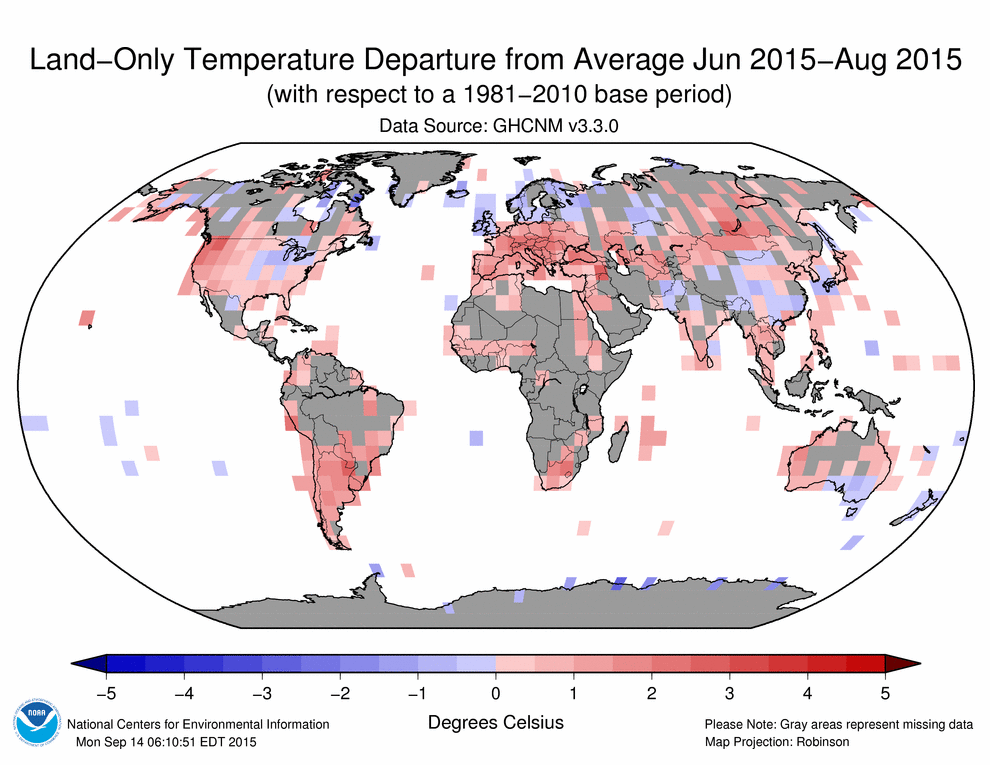By Kevin Stark
Cool summers could soon be a thing of the past in the Chicago area, NOAA climate experts warn.
Major cities in the West scorched their hottest summers on record. California baked through a fourth year of drought conditions. The East Coast drowned under saturating fall rains that crippled much of South Carolina during the first week of October.
But weather from Chicago and throughout the Midwest remained mild and balmy. In fact, the cool summer in Chicago was a global anomaly. according to NASA reports that summer 2015 was the hottest on record.
The air that kept Chicago cool this summer would—in years past—have blown a little further north over Duluth, Minnesota, where Carol Christenson and her family live.
When Christenson wants to stay cool during the hot summer days, she sprays herself with a squirt gun. “That’s what we do in my family,” she said.
This summer the Christenson family did use the squirt guns, but only a few times.
A meteorologist with the National Weather Service in Duluth, Christenson said the region experienced a warm summer, “but not to the point that I wanted to move to Alaska.”
“As someone who does not like warm summers, sometimes I’m like, I want to move to Alaska,” she said.
Meteorologists like Christenson have been observing an increase in global temperature and a corresponding warming of the oceans (sea water expands as it warms). This warming is a contributing factor to global sea-level rise, along with the melting of glaciers in Antarctica and Greenland.
This complicated planet is getting warmer and its weather is getting weirder. Then add in El Niño, a weather system of warm equatorial water in the Pacific Ocean.

As the leaves begin to change in Chicago, meteorologist say conditions are right— warm Pacific waters along the equator—promising a warmer-than-usual winter in the Midwest and much needed rain in Southern California and Nevada.
Although, the climate system has been disrupted by a rapid period of warming. Today, it is much more difficult for meteorologists to make exact climate predictions.
Climate expert doubts drought relief
Scott Stine, a researcher who uses ancient tree stumps to reassemble more than a thousand years of climate in California, says El Nino rains may bypass the drought-stricken Golden State this winter. Federal officials are not making any exact predictions about rainfall either.
Stine’s research shows that California was scorched by two epic droughts, both over 1,000 years ago—one that lasted for 220 years and the other that lasted for 140 years. He is a geomorphologist and paleoclimatologist in Geography and Environmental Studies at California State University in East Bay.
“They call these the Stine droughts,” he said. “I wish they didn’t.”
Stine used radiocarbon dating techniques to analyze tree stumps that grew in the dry beds of lakes in the Sierra Nevada during the two epic droughts. The trees later died as the drought ended and lake levels rose.
Stine said he is “reluctant to accept” the predictions that the El Niño will bring rain to the West and a mild winter to the Great Lakes region. While he said it is clear that historically these conditions have brought rain to the West, he is unsure how a persistent and unusual pool of “very warm water” in the Gulf of Alaska will impact even a strong El Niño. The Gulf waters could amplify or reduce El Niño.
“We do not know what happens with these conditions,” he said. “We are living in a new world” with climate change.
Federal officials and climatologists say that the current ocean temperatures and atmospheric circulation are extraordinary. For this reason, they are hesitant to make any definitive predictions about this winter’s weather.
Carbon dioxide emissions continue to rise globally. Greenhouse gas continues to be trapped in the atmosphere and rise temperature globally. Cool summers like Chicago’s most recent will be only memory as the global trend continues hotter and weather becomes even less predictable.
Much of the heat is being produced by warm water in the Pacific Ocean. The warm water is changing atmospheric circulation and the movement of wind across North America, a phenomenon called El Niño.
NOAA scientists are predicting with near certainty that the upcoming winter will have a strong El Niño that lasts until spring, which in the past has drenched the West with rain and made for mild winters in Illinois.
Kevin Donofrio and his family like to go to the pool during hot weather, but this past summer was very cool where they live in Romeoville, Illinois.
Donofrio, a meteorologist with the National Weather Service, spent less time swimming and more time cutting the grass that grew because of all the rain.
“This summer I was like, ‘What is going on?’” he said.
So, why was it so chilly in Chicago when this year is on track to be the hottest ever recorded?
Donofrio said this is the way in which weather moves in waves across North America. This summer, a persistent high pressure system in the West caused a dip in a jetstream that pushed cool winds and storms south of the Great Lakes and kept him out of the pool.
“What goes up must come down,” Donofrio said

The average summer high temperature was 79.9 degrees for Northeastern Illinois—2 degrees below the normal average high temperature, according to the National Weather Service.
The full impact of rising global temperatures is still unclear to meteorologists like Donofrio. But he said “the consensus is that we are in a period of warming and humans have played a part; the atmosphere is responding.”
Fourteen of the warmest 15 years in recorded history have happened since the year 2000, according to an analysis by Climate Central, a nonprofit that researches and reports on climate change.


